From the threatened and elusive Kirtland’s snake to the hardy and abundant DeKay’s brownsnake, this Midwestern state will surprise you with its snake diversity.
There are 40 species of Illinois snakes in total. Let’s take a look at the state’s four venomous species, the most frequently seen harmless species, and its most iconic snakes.
I’ll provide you with tips on how to stay safe around snakes, the best ways to coexist with them, and supply you with a list of helpful contacts at the end.
Illinois is home to a diverse array of snake species, ranging from harmless grass snakes to venomous vipers. In total, there are around 40 different types of snakes that can be found in the state. While a small number of these snakes pose potential danger to humans, most species are completely harmless and play an important role in the local ecosystems.
In this article, we’ll take a closer look at many of the snake species found in Illinois, discussing how to identify them, where they live, what they eat, and more. We’ll also overview the main differences between venomous and nonvenomous snakes and provide tips for safely viewing or removing snakes from your property.
Venomous Snakes in Illinois
There are only four venomous snake species found in Illinois
Copperhead
The copperhead is a type of pit viper found throughout Southern Illinois. Adults range from 20-37 inches long and have a stout, reddish-brown body with darker hourglass-shaped crossbands.
Copperheads venom is rarely fatal but can cause severe pain and swelling. Luckily, they often deliver “dry” warning bites without injecting venom. Copperheads are found in forests and woodlands, especially near rocky areas.
Cottonmouth
Also called water moccasins, cottonmouths are semi-aquatic pit vipers found in the far Southern tip of Illinois. They have thick, heavy bodies that can reach up to 35 inches long. Cottonmouths are usually dark-colored with a white interior mouth.
Their potent venom can lead to serious injury but is very rarely fatal to humans Cottonmouths prefer swamps, marshes, and slow moving streams and rivers.
Timber Rattlesnake
Timber rattlesnakes are large, heavy-bodied vipers that can reach over 5 feet in length. They have dark crossbands on a yellowish-brown body and the distinctive rattle on the tail.
Timber rattlesnake bites can be extremely dangerous but are rarely fatal with proper medical treatment. These snakes occupy various habitats including forests, river floodplains, and prairies.
Massasauga Rattlesnake
The massasauga is a small rattlesnake, averaging around 2 feet long, with dark oval blotches on a light brown body. They inhabit wet areas like swamps, marshes, and wet prairies across Illinois.
Bites can be very painful and damaging but are rarely fatal. Massasaugas are shy and avoid humans whenever possible.
Nonvenomous Snakes in Illinois
The remaining 36+ snake species found in Illinois are nonvenomous and generally harmless to humans. Here are some of the most notable:
Garter Snakes
Several subspecies of the common garter snake are found statewide. They have striped color patterns in shades of brown, gray, and green. Garter snakes thrive in moist habitats near water sources.
They eat small prey like frogs, earthworms, and rodents. Garter snakes are nonvenomous but release a foul-smelling musk when threatened.
Water Snakes
There are 8 species of water snake in Illinois that occupy lakes, rivers, streams, and wetlands. Most have brown or gray coloration with dark blotches or bands. They prey on fish, frogs, crayfish, and small mammals.
Water snakes are often mistaken for cottonmouths. They are nonvenomous but bite readily if threatened.
Kingsnakes
Kingsnakes come in a variety of colors like black, brown, or tan. They have smooth scales and powerful bodies that can reach up to 5 feet long. Kingsnakes kill their prey by constriction and eat other snakes, including venomous species.
Rat Snakes
Several rat snake species live in Illinois, notably the black rat snake and gray rat snake. They are expert climbers and prey on small mammals like mice and chipmunks. Rat snakes can range from 3-6 feet long. They are nonvenomous and use constriction to kill prey.
Hognose Snakes
The eastern and plains hognose snakes are masters of deception. When threatened, they flatten their necks, hiss, and strike with a closed mouth. If that fails, they roll over and play dead with their mouth open and tongue hanging out.
Milk Snakes
Milk snakes are named after the false myth that they milk cows. They have tan, brown, or reddish bodies with darker blotches. Milk snakes are found statewide in forests, farms, and parks. They eat rodents, lizards, and other snakes.
Grass and Green Snakes
Slender green snakes and smooth green snakes have bright green coloration that provides excellent camouflage in vegetation. They reach 1-2 feet long and prey on insects, spiders, and tree frogs. Grass snakes are docile and rarely bite if handled.
Tips for Safely Viewing and Removing Snakes
Follow these tips to safely view or remove snakes from your Illinois property:
-
Carefully identify any snakes you encounter before taking action. Many nonvenomous species are mistaken for dangerous cottonmouths or copperheads.
-
If you spot a venomous snake, leave it alone and alert others to its presence. Do not try to catch or kill venomous snakes – this often leads to bites.
-
To remove a nonvenomous snake, gently pick it up with a long stick or snake hook and place it in a cloth bag or bucket. Then release the snake outdoors far away from your home.
-
Eliminate habitat attractants like wood piles, tall grass, and rodent infestations to discourage snakes from entering your yard.
-
Install snake-proof fencing around play areas or gardens if snakes are frequently spotted on your property.
-
Educate children to avoid touching snakes and immediately tell an adult if they see one.
-
Seek medical attention immediately if you are bitten by any snake. Try to identify the species but don’t risk another bite by trying to kill it.
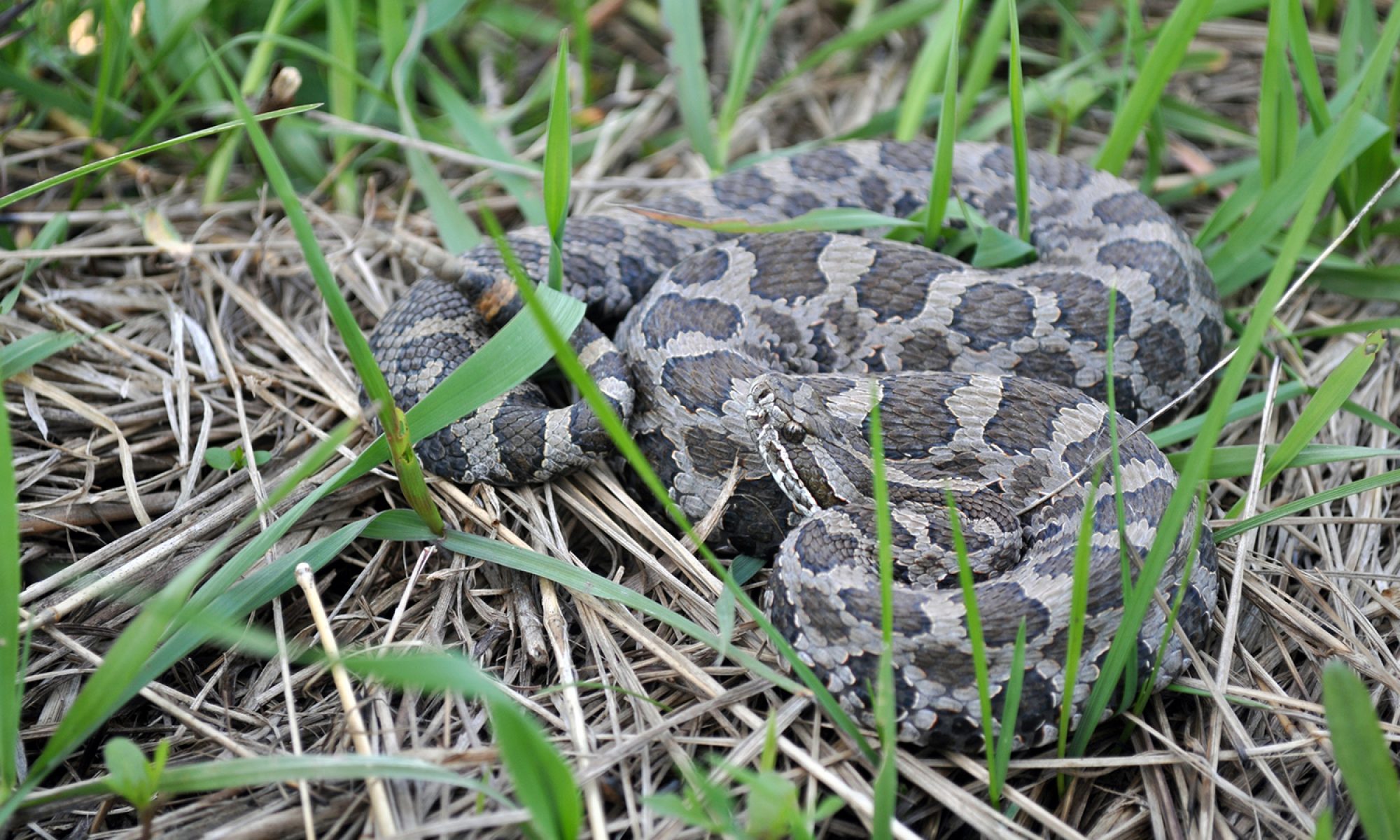
Quickly Identifying Illinois Venomous Snakes
All venomous snake species in Illinois are pit vipers. They belong to a group of venomous snakes called the Viperidae family.
Pit vipers share traits that make them easily distinguishable from the harmless snake species of Illinois.
They all have:
- Elliptical pupils – Vertical pupils shaped like cat eyes
- Heat-sensing pits – Large sensory pits between each eye and nostril to help the snake locate prey
- Broad, triangular heads – Heads widened by venom glands behind the jaw
- A single row of scales under the tail – Most harmless species have two rows of scales on the underside of the tail
Fun Fact: People often mislabel these species as poisonous snakes in Illinois. However, poison is something you ingest.
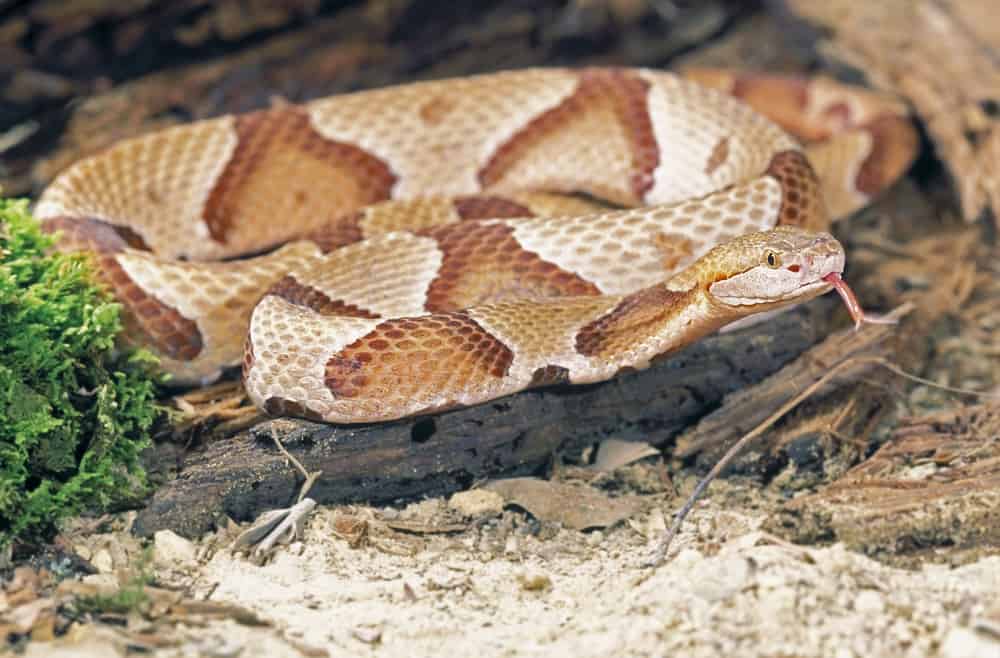
| Scientific Name: | Agkistrodon contortrix |
|---|---|
| Range: | Southern third of Illinois, in the Lower Illinois River valley
You may find these snakes in Central Illinois |
| Adult Size: | 24-36 inches |
| Description: | Heavy-bodied
Elliptical pupils and sensory pits on a broad head Copper-red head, rusty-brown or yellow-brown body, keeled scales, reddish-brown hour-glass shaped bands Juveniles have a green tail tip |
| Habitat: | Woodlands, rocky hillsides, and along forest edges |
| Diet: | Diet generalist, mainly mice, but also birds, lizards, other snakes, insects, and amphibians |
| Venomous/Non-Venomous: | Venomous |
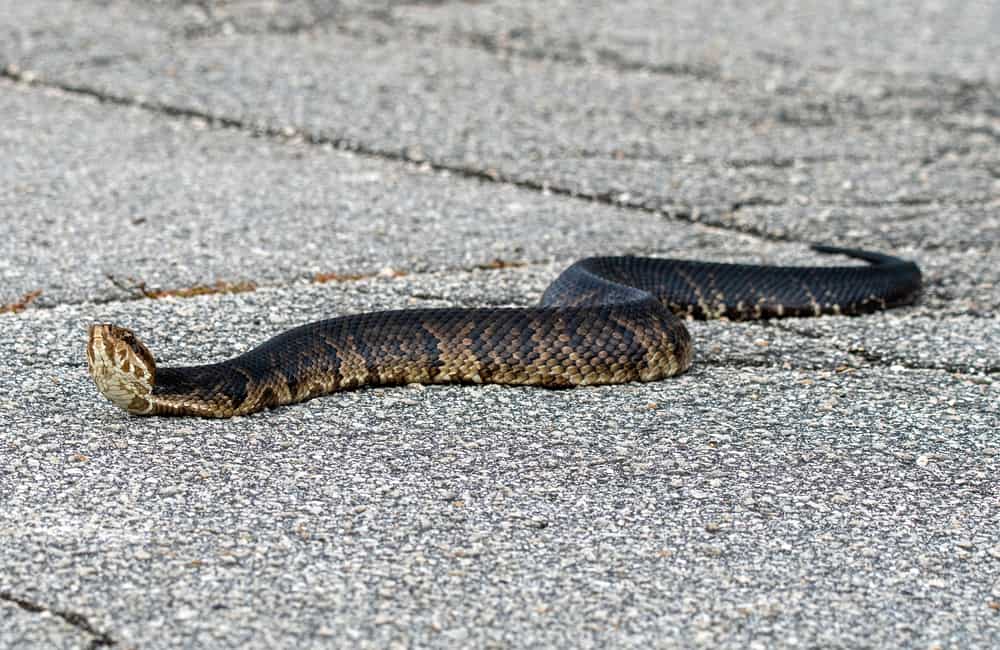
| Scientific Name: | Agkistrodon piscivorus |
|---|---|
| Range: | Tip of Southern Illinois |
| Adult Size: | 30-42 inches |
| Description: | Flat, wide head
Elliptical pupils and heat-sensing pits Thick-bodied with keeled scales May have dark bands or be solid black or brown Juveniles have a green tail tip |
| Habitat: | Swamps, sloughs, and lakes |
| Diet: | Mice, fish, birds, lizards, amphibians, insects, and other snakes |
| Venomous/Non-Venomous: | Venomous |
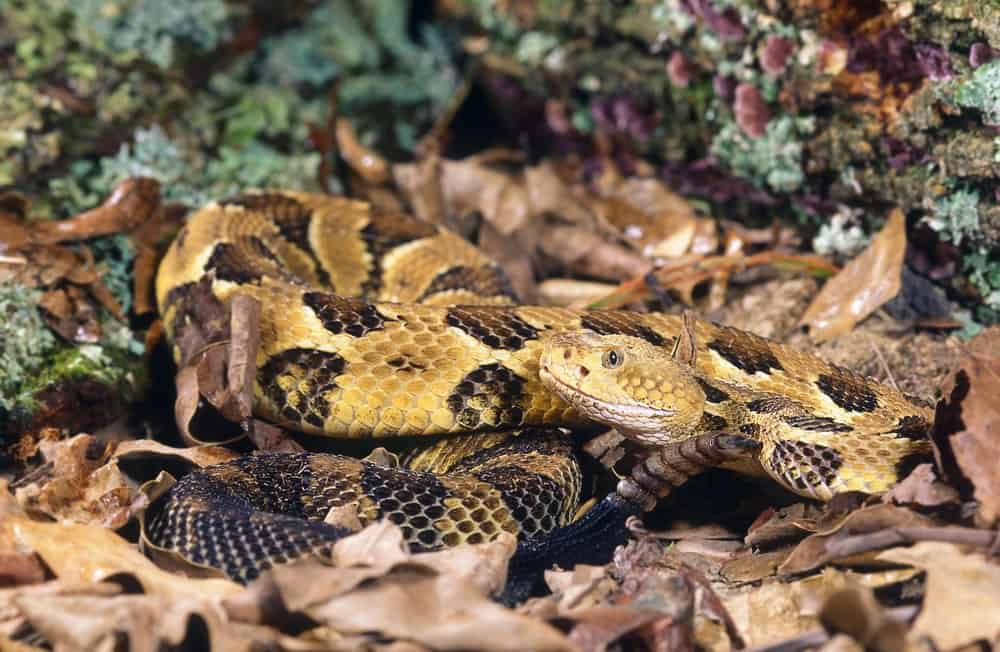
| Scientific Name: | Crotalus horridus |
|---|---|
| Range: | Southern third of Illinois and along the Mississippi River in the west
Found in the lower Illinois River valley and the Mississippi River valley |
| Adult Size: | 36-60 inches |
| Description: | Distinct rattle at the end of the tail
Elliptical pupils and sensory pits on a flat, wide head Gray or yellow with dark, V-shaped bands, a rust-colored dorsal stripe, and keeled scales May have a dark line between the eye and jaw |
| Habitat: | Forested bluffs, rocky outcroppings, and fields |
| Diet: | Rodents, birds, frogs, and lizards |
| Venomous/Non-Venomous: | Venomous |
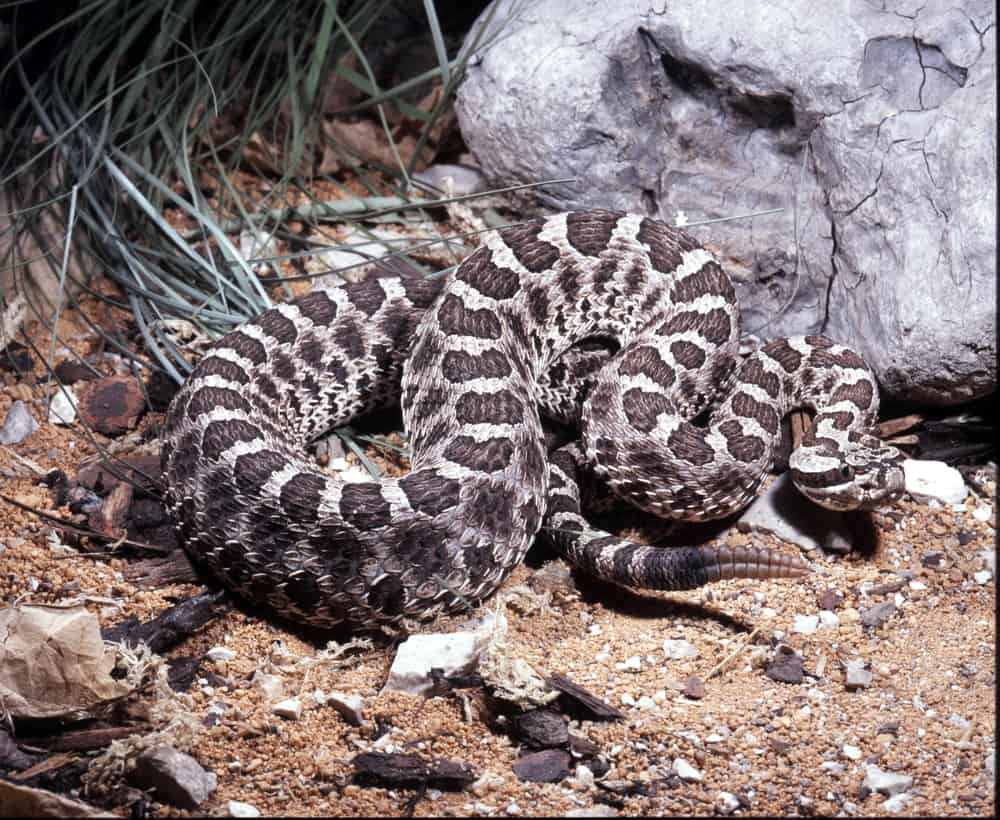
| Scientific Name: | Sistrurus catenatus |
|---|---|
| Range: | Northern two-thirds of Illinois
The only venomous species not found in Southern Illinois |
| Adult Size: | 18-30 inches |
| Description: | Keeled scales
Rattle at the tip of the tail Elliptical pupils and a wide head typical of pit vipers Gray body with dark blotches down the back and three rows of dark spots along the sides |
| Habitat: | Wet prairies, bogs, and fields |
| Diet: | Mice, birds, frogs, and other snakes |
| Venomous/Non-Venomous: | Venomous |
Illinois Snake Identification Basics
There are several significant components to consider when identifying snakes.
The most important features include:
- Size – Different species in Illinois range in maximum size, from less than a foot, to seven feet in length. Taking note of how long a snake is can help you distinguish it from similar-looking species.
- Pupils – All venomous snakes in the state have elliptical pupils, while all of the non-venomous snakes have round pupils.
- Location – Geographic location and habitat type will help you narrow down which snakes are likely to be in the area where you found the snake. Some snakes have specific habitat preferences. The Western ribbon snake, for example, prefers wet habitats and is only found along the Mississippi River in Illinois. There are many snakes in Southern Illinois that you won’t encounter anywhere else in the state. If you’re looking at snakes in Northern Illinois, they definitely won’t be species like the great plains rat snake or red-bellied mud-snake.
- Coloration – A snake’s pattern and coloration are some of the most valuable identifiers, yet they can also be deceiving. You definitely won’t mistake a solid green species like the smooth green snake for a patterned rattlesnake species. However, it’s easy to mix up species like the lined snake, plains garter snake, and common garter snake.
You’re most likely to successfully identify a snake when combining all of these attributes.
Because snake characteristics often vary geographically, this guide is only for Illinois snake Identification.
Illinois’ Venomous Snakes
FAQ
Are there any poisonous snakes in Illinois?
Four native Illinois snake species are venomous: the copperhead, cottonmouth, timber rattlesnake and the massasauga. Venom is a toxin for subduing prey.
What are the most snake-infested lakes in Illinois?
- Lake Shelbyville.
- Garter Snake (Thamnophis sirtalis) basking in Illinois.
- Northern Water Snake (Nerodia sipedon)
- Rend Lake, Illinois.
- Eastern Ribbon Snake (Thamnophis saurita)
- Eastern Copperhead a venomous snake in Illinois (Agkistrodon contortrix)
- Carlyle Lake at Eldon Hazlet State Park Illinois.
What is the most common snake to find in your backyard?
- 1. Rat Snakes. Rat snakes come from the Colubridae snake family. …
- Garter Snakes. Garter snakes are small to medium-sized and often found in North America. …
- King Snakes. …
- Gopher Snakes. …
- Banded Water Snake.
Are rattlesnakes common in Illinois?
Venomous Snakes
In Illinois, the timber rattlesnake is listed as a threatened species and the massasauga is listed as endangered. The cottonmouth is found only in the very southern tip of the state. The copperhead is found in the southern two-thirds of the state.
